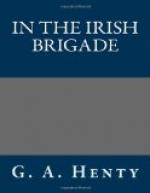For two months the little force moved about in Catalonia, the rapidity of its marches baffling the attempts of the archduke’s forces to interfere with its operations. These were principally directed against various small fortresses, held by partisans of Charles. Several of these were captured, thus clearing the roads they guarded, and opening the country for the more important operations that Philip himself was about to undertake.
It was not until July that the royal army approached Lerida, where O’Mahony’s force joined it. General Stanhope marched, with the troops under his command, and encamped at Balaguer; where he was joined by Baron de Wetzel, with some troops which had been brought from Italy. As Stanhope’s force was insufficient to give battle until joined by the main army of Charles, he marched, on the 31st of July, headed by two English and two Dutch regiments of dragoons, to secure the passes near Alfaro, and so check the advance of the Spaniards.
After performing a long and difficult march, they took up a defensive position. Stanhope found, however, that the river in front of him was so low that cavalry and artillery could pass easily, and even infantry could cross without difficulty. Scarcely had he taken up his position when two brigades of infantry and nineteen squadrons of cavalry were seen approaching, having been detached from the Spanish army to occupy the position which had been secured by the rapidity of Stanhope’s march. They therefore waited for their main army to come up, but before it did so, the whole of Stanhope’s force had arrived, and was prepared for battle.
Although it was past six o’clock in the evening, Charles, on his arrival, decided to fall upon the enemy before they could encamp, which they might do in a position in which it would be difficult to attack them. Fourteen cannon at once opened fire from an eminence, whence they commanded the position taken up by the advance force of the Spaniards. This position was on low ground in front of the ridge upon which the village of Almenara stood, and nothing could be seen of the force that lay behind this ridge.
The advanced force of Spaniards ascended this ridge, as soon as the artillery opened upon them, and General Stanhope obtained leave from Marshal Staremberg, who commanded the archduke’s army, to charge them. With ten squadrons of horse he rode up the ascent, and there, when he gained it, saw to his surprise twenty-two squadrons facing him, flanked with infantry, and supported with another line of cavalry equally strong. He sent back at once for fourteen squadrons from his second line, and when six of these came up he advanced against the Spaniards, who at the same time moved forward to meet him.
The cavalry on Philip’s left at once gave way. The centre and right, aided by the fire of the infantry, made a stout fight, but were driven back by the English and Dutch cavalry. The fighting was severe, for of the six English squadrons who charged, two hundred men and twenty-one officers were killed or wounded.




